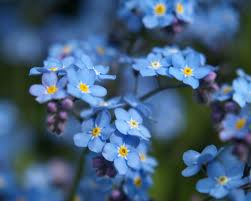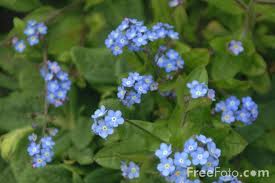Forget Me Not
by Taffy Cannon

My paternal grandmother painted china and one of her most persistent and beautiful floral themes was the forget-me-not, clusters of tiny blue flowers that always seemed too exquisite and idealized to be real. And yet…
When I became a gardener as an adult, I wanted to grow forget-me-nots, but they weren’t available locally, even in floriculturally diverse Southern California. On several occasions I ordered baby plants from faraway nurseries, not precisely sure what variety my grandmother had painted, or if she had even painted from nature at all. The plants were always tiny little things when they arrived, and I’m sorry to say that none of them survived to adulthood. So I never knew if I’d had my finger on the real deal, or was just flirting with an imaginary floral friend.
Until.
One year, I planted a packet of mixed flower seeds directly into a garden bed. It was called something like “Heralds of Spring” and included dozens of varieties, most of them only vaguely familiar to me. I had no idea what to expect, and had to wait in most cases until something blossomed before I could identify the plant.
Some odd little bushy plants with soft green leaves puzzled me as they grew to maturity. Then one day their tiny flowers opened and I realized that I had inadvertently grown exactly what I’d been searching for all those years. Forget-me-nots were blooming in my garden, the same ones that graced the tea service and serving dishes protected behind glass in my china cabinet. What’s more, these flowers were every bit as exquisite in their living version as in the porcelain classics. Purely by accident, I had introduced myosotis into my garden, and it’s been there ever since.
Those original forget-me-nots have passed through countless new generations since then. They bloom profusely and reseed freely, scattering their sweet blossoms and gentle foliage beneath rose bushes and throughout perennial beds. They’re annuals, technically, though in this frost-free climate plants will generally last for a couple of years before wearing out. When they go to seed, they create sticky little pods that cling to anything they touch, and thus they travel to new sections of the garden via boots and pantlegs and cat paws.
Now I am taking this flower, with all its family history and symbolism, as the theme of my new blog, moving it from one of the oldest forms of media to one of the newest, from the permanent to the ephemeral.
Forget me not. Please.
